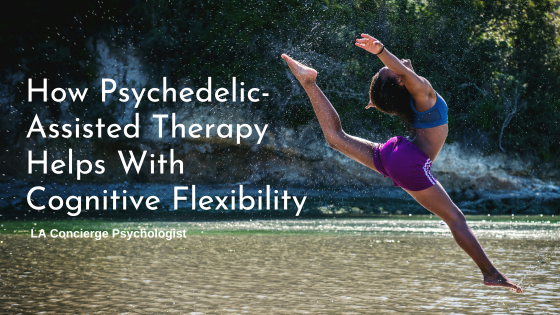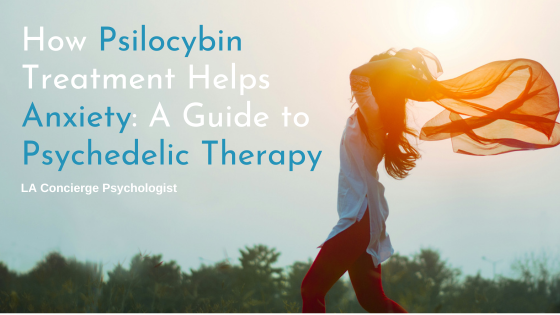Though research is still being carried out, it’s clear that psychedelic assisted therapy (or sometimes referred to as just “psychedelic therapy”) offers powerful potential for healing and growth. By combining carefully administered psychedelic substances, such as psilocybin or ketamine, with professional therapeutic support, it offers another option for conditions that have long resisted traditional treatments. From treatment-resistant depression to end-of-life anxiety, from PTSD and addiction recovery, psychedelic assisted therapy is demonstrating remarkable potential to catalyze profound healing and personal transformation.
Unlike conventional therapy, which typically requires months or years of regular sessions to achieve breakthrough insights, psychedelic therapy can sometimes facilitate deep realizations and emotional releases in just a few carefully guided sessions. However, this isn’t a quick fix or magical solution. As with any significant therapeutic undertaking, the power of this approach lies in its combination of the psychedelic experience itself with thorough preparation beforehand and crucial integration work afterward— all conducted under professional guidance in a controlled, therapeutic setting.
The field of psychedelic assisted therapy continues to evolve rapidly. We’re likely to see expanded access to treatment and increased insurance coverage as research progresses. More training programs for therapists are emerging, while treatment protocols become increasingly refined for specific conditions.
This guide explores who might benefit from psychedelic therapy, what conditions it can address, and important considerations for those interested in this emerging therapeutic approach.
Understanding Psilocybin and Psychedelic Assisted Therapy
Psychedelic therapy combines the careful use of psychedelic substances, like psilocybin and ketamine, with professional therapeutic support. Unlike recreational use, this structured approach takes place in a controlled setting with trained practitioners who guide participants through preparation, the experience itself, and crucial integration afterward.
Recent scientific breakthroughs have shed light on exactly how psychedelics create their therapeutic effects in the brain[1]. At their core, these substances work by promoting neuroplasticity— the brain’s remarkable ability to form new connections between neurons. Think of it as opening windows of opportunity for the brain to rewire itself in potentially healthier ways.
The science behind this process is fascinating. Research has revealed that psychedelics work differently from traditional psychiatric medications. While many conventional treatments, like antidepressants, affect serotonin levels on the surface of brain cells, psychedelics appear to work through a more complex mechanism. They can actually enter neurons and activate specific receptors in the brain (called 5-HT2A receptors)[2] from inside the cell, triggering the growth of new connections between neurons.
These new connections take the form of structures called dendritic spines, tiny branches that allow neurons to communicate with each other. When psychedelics activate the internal receptors, they stimulate the growth of these vital communication points, potentially allowing the brain to break free from rigid patterns of thinking and behavior that characterize conditions like depression, anxiety, and PTSD.[3]
It’s important to understand that the biological effects of psychedelics are just one part of the therapeutic process. The psychological preparation before sessions, the supervised setting during the experience, and the integration work afterward all play vital roles in translating these neurobiological changes into lasting therapeutic benefits.
What Makes Psychedelic Assisted Therapy Different From Traditional Therapy?
Traditional therapy typically requires months or years of regular sessions to achieve breakthrough insights. Psychedelic therapy can sometimes catalyze profound realizations and emotional releases in just a few sessions. By promoting neuroplasticity, psychedelics may create a temporary state where the brain becomes more adaptable and open to change. When combined with professional therapeutic support, this window of enhanced plasticity can facilitate profound shifts in perspective and behavior.
Though research is still being carried out into the exact environment that would be most beneficial for psychedelic assisted therapy, current suggestions emphasize the importance of “building rapport, ‘letting go’ of resistance, promoting openness, and reliance on unconscious processes.”[4]
What Are the Benefits of Psychedelic Therapy?
While each individual’s journey and needs are unique, research has identified several populations who may particularly benefit from psychedelic therapy. Current clinical trials and treatment programs are showing especially promising results for people dealing with specific mental health challenges that have proven resistant to conventional treatments.
These early findings are especially encouraging as they often involve conditions where traditional therapies and medications have limited effectiveness.
Mental health conditions where psychedelic therapy can be effective
- Depression: Research shows particular promise for treatment-resistant depression.
- Anxiety: It’s been show to help with most forms of anxiety, especially existential anxiety related to terminal illness.
- PTSD/C-PTSD: It can help process trapped trauma in new ways.
- Addiction: It’s shown effectiveness in treating both substance dependencies and behavioral addictions.
- OCD: Early research indicates potential benefits for obsessive-compulsive patterns.
Beyond clinical conditions, psychedelic assisted therapy can benefit individuals seeking greater self-awareness and insight, enhanced creativity, and improved problem-solving abilities. Many participants report deeper connections in their relationships and enhanced emotional intelligence.
The experience often catalyzes spiritual exploration and meaning-making while helping individuals break free from destructive patterns or habits that have resisted other interventions.
How Psychedelic Assisted Therapy Helps These Different Groups
People with treatment-resistant depression
For those who haven’t found relief through traditional antidepressants or talk therapy, psychedelic therapy offers a different approach.[5] The experience can help break negative thought patterns and provide new perspectives on life’s challenges. Many report feeling reconnected to a sense of meaning and wonder that depression had stripped away.
Trauma survivors, PTSD, and C-PTSD
Trauma often creates frozen patterns in the nervous system that talk therapy can struggle to access. Psychedelic assisted therapy can create a safe space where individuals can process traumatic memories with less overwhelming fear, allowing new neural pathways to form.[6] The experience can help people move from feeling stuck in trauma and experiencing PTSD and C-PTSD to find new freedom and resilience.
Those facing end-of-life anxiety
Terminal illness often brings existential distress that’s difficult to address through conventional means. Psychedelic therapy has shown remarkable results[7] in helping individuals come to terms with mortality, find peace, and reduce anxiety about death. Many report profound spiritual experiences that transform their relationship with death and dying.
Addiction recovery
Within addiction recovery, psychedelic therapy offers unique opportunities for transformation.[8] Participants often gain deep insights into the root causes of their addictive patterns, experiencing breakthroughs in understanding their behaviors. The treatment helps break habitual thought cycles while increasing motivation for change. Many find enhanced connection to meaning and purpose, which strengthens their resilience against relapse.
Cognitive flexibility, for creativity and problem-solving
Many individuals in creative fields or high-pressure problem-solving roles find psychedelic assisted therapy particularly beneficial.[9] The experience often helps break through creative blocks, helps with cognitive flexibility, and access entirely new perspectives on challenges. Users report enhanced pattern recognition abilities and innovative thinking, along with reduced performance anxiety that may have been limiting their potential.
The Three Stages of Psychedelic Assisted Therapy — What to Expect
The psychedelic therapy process has three distinct stages[10] that guide patients through the experience facilitating profound therapeutic outcomes.
1) Preparation
Before embarking on the psychedelic experience, people work closely with a therapist or treatment team. This preparatory stage is crucial for exploring your intentions, identifying the issues you hope to address, and building a foundation of trust and rapport.
The therapist also takes this time to thoroughly brief the patient on any physical and psychological effects you may encounter, providing guidance and coping strategies for navigating various terrain during the sessions.
The preparation phase sets the foundation for success, enabling you to get the most therapeutic benefit out of your psychedelic journey.
2) Medication
The core psychedelic experience takes place under the direct supervision of the therapist or treatment providers. Typically, a full course of treatment involves one to three medication sessions, spaced out over several weeks, with each session lasting between six to eight hours.
The psychedelic substance is administered in a comfortable, controlled environment, with the patient lying on a bed or couch. Facilitators may adopt different approaches during this phase – some maintain a neutral, observational stance, while others actively guide the patient through challenging emotional material that arises. In the preparation stage, you should have a sense of what your therapist’s style is (and can let them know what you prefer).
During supervised sessions, participants benefit from a safe, comfortable environment with professional monitoring throughout. Emotional support remains readily available, while still allowing freedom for internal processing. Many programs incorporate supportive elements like carefully selected music or eye masks to enhance the therapeutic experience.
3) Integration
In the post-session integration phase, therapists work closely with patients to unpack their experiences, interpret the insights gained, and translate them into meaningful, lasting change. These non-drug sessions often occur during the “afterglow” period, when patients may exhibit increased neuroplasticity, making them more receptive to restructuring their inner narratives, relationships, and perspectives on their circumstances.
The period following sessions proves crucial for long-term success. Regular integration meetings help participants process their experiences and implement insights. Practitioners provide practical tools for navigating challenges that arise, while connecting clients with community resources and ongoing therapeutic support as needed.
The integration work is pivotal, helping patients apply the breakthroughs from the psychedelic experience to their everyday lives.
Who Should Not Pursue Psychedelic Assisted Therapy
Certain individuals should be more cautious with regards to psychedelic therapy, including those with a personal or family history of psychosis or schizophrenia and people with severe cardiovascular issues. Those taking certain medications that could interact dangerously should also abstain. It’s advised to discuss any worries or concerns with a therapist and your doctor.
Additionally, anyone with unstable mental health conditions or those who feel pressured rather than personally motivated should not pursue this treatment.
Making an Informed Decision
Before pursuing psychedelic assisted therapy, carefully consider your readiness for potentially profound changes and assess your support systems. Reflect on your commitment to the full preparation and integration process. Ensure you’re pursuing treatment for yourself rather than due to external pressure, and thoroughly research both risks and benefits.
For those interested in exploring psychedelic therapy, begin by consulting healthcare providers about eligibility. Research local legal options and requirements while connecting with qualified practitioners. Start preparing yourself mentally and emotionally, and develop a strong support network for your journey.
Common Misconceptions of Psychedelic Assisted Therapy
Despite growing acceptance, misconceptions about psychedelic assisted therapy persist. It’s important to understand that this isn’t about “getting high” or escaping problems– rather, the process often involves facing challenging emotions and memories directly. Additionally, while breakthrough experiences can be profound, they require integration and ongoing work to create lasting change. Finally, legal psychedelic therapy differs significantly from recreational use, with numerous safeguards and professional support in place.
It’s Important to Work with a Professional Therapist if You’re Considering Psychedelic Assisted Therapy
Professional support offers crucial benefits that self-administration cannot match. This includes proper safety screening, expert guidance through challenging moments, and help processing and integrating insights.
Email Dr. Lee with any questions or information on accessing harm-reduction focused integration sessions.



